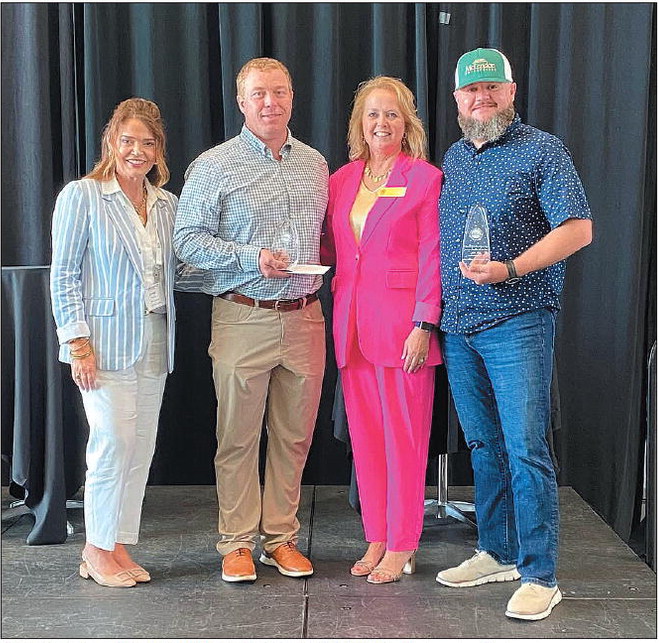In the Short Rows: - Container Plant Basics
In the Short Rows:
Despite the chilly temperatures we’ve experienced the past several days, spring has sprung. For many of us, this means getting to work preparing flower beds, landscaping, gardening, and more.
Last weekend, I found myself at the Montgomery FFA plant sale stocking up on herbs, ferns, and annuals. After I left with my flat of plants, I began to make plans in my head for what containers and supplies I’d need to buy. Container plants are a great way to add visual interest to an area, whether you’re working with a large yard or a smaller patio area.
The soil around ground plants drains by capillary action, which naturally pulls excess water downward. Container plants drain more slowly due to their shallow planting depth and reduced capillary action. Poorly drained container plants can experience root issues caused by fungi present under conditions of excess moisture and poor aeration. This can cause stunted/irregular growth or plant death. To combat this, container plants are planted in a soilless medium, which often contains materials to make it more porous and promote drainage.
Soilless media, which can be purchased at most home/garden stores, are the best option for container plants. Generally, these contain combinations of vermiculite, peat moss, perlite, and pine bark. These blends are made to promote drainage and aeration. You can also create your own mix by blending a sandy or clay loam soil with organic matter to promote drainage. A mixture of 50% soil and 50% organic matter should be sufficient.
Organic matter amendments (coarse peat moss, pine bark, etc.) can often be purchased separately from a nursery or home/garden store. You may also want to add perlite to your mix to improve drainage. A ratio of two parts soil, two parts peat moss (or pine bark) and one-part perlite will make a good mixture. Make sure when mixing soil that the mixture is blended evenly.
Fertilizer is an important factor when preparing a container mixture, as it supplies nutrients essential for plant growth and development. The fertilizer blend you choose should contain both major and minor elementsblends such as 5-10-15, 5-10-10, or 6-12-12 are recommended. According to the University of Georgia, you should “add fertilizer to the mixture at the rate of 5 pounds per cubic yard (27 cubic feet) of the potting mixture or 3¾ ounces per bushel (1.25 cubic feet) of potting mixture.” You’ll also want to add some dolomitic lime to your mix at the rate of 4-5 pounds per cubic yard of potting mixture. Again, give it a good mix to make sure all of the soilless media elements and fertilizers are evenly distributed!
Containers should be chosen carefully. Color and design are really up to you! Container size and drainage are the most important characteristics to consider. Small pots restrict plant growth, so make sure you choose an adequate size container for the plant. Containers ranging from 3-7 gallons in size are commonly used, as they provide plenty of room for the plants to grow. Containers should ideally have holes in the bottom to allow excess water to escape and decrease the likelihood of root rot and other issues exacerbated by poor aeration and drainage.
When filling your containers, don’t pack the soil tightly. Tap the container to settle the soil and fill it within 2” of the top of the container. Before planting the individual plants, thoroughly wet its root mass and set the plants shallowly before gently firming the soil around the roots. Water the plants in after planting.
If you added fertilizer to your soil mixture, no fertilizer is needed the first 2-3 weeks after planting. Liquid soluble fertilizer should be applied every 2-3 weeks during the growing season, or to promote quicker growth, every 1-2 weeks. A dry fertilizer should be applied every 3-4 weeks. It is recommended to water dry fertilizers in to avoid burning the stems and roots. Always follow all labeled fertilizer rates and instructions to avoid over or under fertilizing.
When it comes to container gardening, consistency is key. Water your plants regularly but be careful not to over-water. Overwatering and underwatering can have almost identical symptoms, and both can lead to eventual plant death. Another issue to look out for is heat stress- with plant roots subject to temperature changes in containers, making sure your plant is in an appropriately sized container and watered regularly will help combat this issue.
If you have any questions, please feel free to contact the Montgomery County Extension Office at 912-583-2240.





